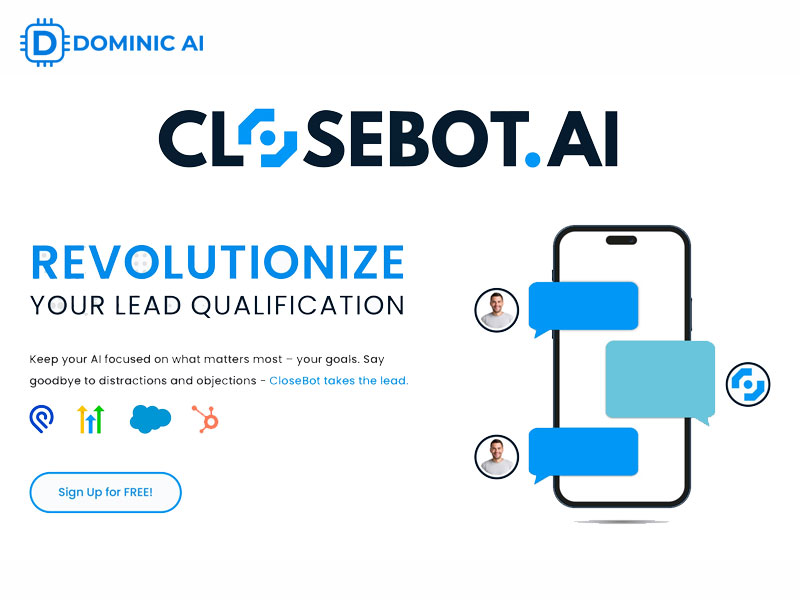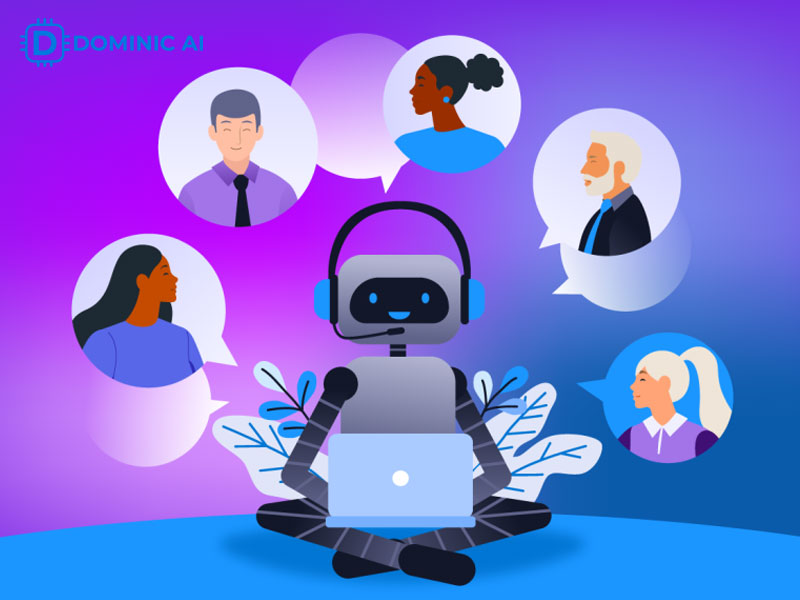How to use CloseBot AI – Step-by-Step Guide

Understanding how to use CloseBot AI is the first step toward unlocking the full potential of AI-driven sales automation and customer engagement. From setting up your account to exploring integrations and optimizing workflows, this tool can transform the way your business operates. To make the process easier, Dominic AI Tools provides practical guidance and resources, helping you explore features, avoid common mistakes, and maximize the value of CloseBot AI from day one.
Getting Started with CloseBot AI
Before you can unleash the power of CloseBot AI, you need to get acquainted with the initial setup and requirements. This involves creating an account and understanding the platform’s technical specifications, ensuring a smooth and efficient onboarding experience. Taking the time to understand these foundational aspects will allow you to customize CloseBot AI to effectively meet the specific needs of your sales team.
How to sign up / create an account.
Creating a CloseBot AI account is generally a straightforward process, although it may vary slightly depending on the specific platform or service you choose. Typically, you would navigate to the CloseBot AI website and look for a “Sign Up” or “Get Started” button. You’ll likely be prompted to enter basic information such as your name, email address, and company details.

Getting Started with CloseBot AI
During the signup process, pay close attention to any options related to subscription plans or trial periods. CloseBot AI likely offers different tiers of service with varying features and pricing. Reviewing CloseBot AI pricing at this stage will help you select the plan that best matches your needs and budget. Furthermore, take the time to carefully read the terms of service and privacy policy before proceeding. Understanding these documents will help you avoid future misunderstandings or compliance issues.
System requirements & supported platforms.
CloseBot AI, like any software, has certain system requirements and supported platforms to ensure optimal performance. These requirements typically include specific operating systems (e.g., Windows, macOS), web browser versions (e.g., Chrome, Firefox, Safari), and internet connection speeds. It’s essential to verify that your hardware and software meet these minimum requirements before installing and using CloseBot AI. Neglecting this step can result in unexpected errors, slow performance, or even compatibility issues that prevent the software from functioning correctly.
Beyond basic system requirements, CloseBot AI may also have specific integration requirements related to other software or services you use, such as your CRM (Customer Relationship Management), email provider, or marketing automation tools. Checking the official documentation or contacting CloseBot AI support for a comprehensive list of supported integrations is wise. Ensuring compatibility between CloseBot AI and your existing tech stack will help streamline your workflow, avoid data silos, and maximize the overall effectiveness of your sales automation efforts.
Setting Up CloseBot AI
Once you’ve established your CloseBot AI account and verified compatibility, the next step is to configure the platform to align with your sales processes. This involves connecting your existing tools, customizing chatbot responses, and managing user permissions. A well-configured CloseBot AI is the difference between a helpful assistant and a frustrating bot.
Step 1: Connect your CRM, email, or sales tools.
Connecting your CRM, email, and other sales tools to CloseBot AI is the cornerstone of creating a seamless and automated sales workflow. This integration allows CloseBot AI to access crucial data, such as lead information, customer history, and deal stages, empowering it to deliver hyper-personalized and contextually relevant interactions. The seamless flow of data between systems eliminates manual data entry, reduces the risk of errors, and frees up your sales team to focus on higher-value tasks, like building relationships and closing deals.

Setting Up CloseBot AI
The integration process typically involves authenticating CloseBot AI with your existing accounts through API keys or OAuth protocols. Before initiating these connections, it’s crucial to carefully review the permissions you are granting to CloseBot AI to avoid potential security risks. Consider using dedicated integration accounts with limited privileges to minimize the impact of any potential breaches. Regularly auditing these connected apps will help you maintain data security and compliance.
Step 2: Customize chatbot responses & automation workflows.
Customizing chatbot responses and automation workflows is where you truly make CloseBot AI your own. Generic chatbot responses can feel impersonal and even alienate potential customers. Tailoring the bot’s language, tone, and content to match your brand voice and target audience is essential for creating engaging and authentic interactions. This involves crafting targeted responses for different stages of the sales funnel, common customer inquiries, and specific product or service offerings.
Beyond simple responses, customizing your automation workflows is about orchestrating a seamless sequence of actions based on customer behavior. This could include automatically sending follow-up emails after a website visit, scheduling personalized demo calls for qualified leads, or escalating complex issues to a human sales representative. By carefully mapping out these workflows, you can nurture leads, close deals, and provide exceptional customer service, all while freeing up your sales team from repetitive tasks. Remember to continuously A/B test your responses and workflows to optimize their effectiveness and ensure they are delivering the desired results.
Step 3: Configure user permissions and roles.
Configuring user permissions and roles within CloseBot AI is essential for maintaining data security and ensuring that each member of your sales team has the appropriate level of access. By assigning specific roles and permissions, you can prevent unauthorized access to sensitive information, maintain data integrity, and ensure compliance with relevant regulations. Common roles might include administrators, sales managers, and individual sales representatives, each with varying levels of access to features and data.
When configuring user permissions, it’s crucial to adopt a principle of “least privilege.” This means granting each user only the minimum level of access necessary to perform their job duties. For example, individual sales representatives might need access to lead information and deal management tools, while administrators require broader access to configure settings and manage user accounts. Regularly reviewing and updating these permissions as roles change or new features are added is a best practice to mitigate security risks and maintain a well-governed system.
Key Features and How to Use Them
CloseBot AI extends beyond a simple chatbot. It’s a comprehensive sales automation platform with a multitude of valuable features. Understanding and harnessing these key features is crucial for maximizing your return on investment and achieving your sales goals. From personalized customer interactions to insightful analytics, CloseBot AI empowers you to optimize every aspect of your sales process.
Chatbot & Conversation AI – setting up customer interactions.
CloseBot AI’s chatbot and conversation AI capabilities are at the heart of its functionality, enabling you to automate customer interactions across various channels. Setting up these interactions involves defining the chatbot’s personality, designing conversation flows, and training it to understand and respond to customer inquiries effectively. A well-designed chatbot can handle a wide range of tasks, from answering frequently asked questions to qualifying leads and even booking sales appointments.

Key Features and How to Use Them
When setting up customer interactions, it’s crucial to prioritize personalization. Instead of relying on generic responses, leverage data from your CRM and other sources to tailor the chatbot’s interactions to each individual customer. This personalization can include addressing the customer by name, referencing past interactions, or recommending relevant products or services based on their purchase history. By creating a more personalized experience, you can increase customer engagement, build trust, and improve conversion rates. Remember that even the most sophisticated AI needs to sound human to be truly effective.
Sales Automation – automating follow-ups, reminders, and deals.
Sales automation is where CloseBot AI truly shines, allowing you to streamline repetitive tasks, improve efficiency, and ensure that no lead falls through the cracks. This feature encompasses a wide range of automations, including follow-up emails, appointment reminders, deal stage updates, and task assignments. By automating these tasks, you can free up your sales team to focus on building relationships, closing deals, and other higher-value activities.
When configuring your sales automation workflows, it’s crucial to think strategically about the entire customer journey. Map out the key touchpoints in your sales process and identify opportunities to automate tasks that can improve efficiency and customer experience. For example, you might automate the sending of a welcome email after a lead signs up for a free trial, or trigger a follow-up sequence if a lead hasn’t engaged with your website in a certain period. Regular monitoring and optimization are crucial to ensure that your automation workflows are performing as expected and delivering the desired results.
Analytics & Reporting – tracking performance metrics.
CloseBot AI’s analytics and reporting features provide valuable insights into the performance of your sales efforts, allowing you to track key metrics, identify trends, and optimize your strategies. These features typically include dashboards that display metrics such as lead generation, conversion rates, deal closure rates, and customer satisfaction. By closely monitoring these metrics, you can gain a deeper understanding of what’s working well and what areas need improvement.
When utilizing the analytics and reporting features, it’s crucial to define clear goals and objectives for your sales efforts. Without clear goals, it’s difficult to determine whether your efforts are successful or not. Start by identifying your key performance indicators (KPIs) and then use the CloseBot AI analytics to track your progress towards those KPIs. Regularly reviewing these reports and making data-driven decisions is essential for maximizing your sales performance and achieving your business objectives. Don’t just collect the data – use it to improve your process.
Integrations – linking with third-party apps for extended functionality.
CloseBot AI’s integration capabilities are crucial for connecting it with your existing tech stack and extending its functionality beyond its core features. Integration with third-party apps, such as CRMs, email marketing platforms, and communication tools, allows you to create a seamless and unified sales workflow. This integration can streamline data transfer, automate tasks, and provide a more holistic view of your customer interactions.
When exploring integrations, it’s essential to prioritize those that align with your specific business needs and address your biggest pain points. Consider which apps are most critical to your sales process and then look for integrations that can automate tasks, improve data accuracy, or provide valuable insights. Before implementing any integration, carefully review the documentation and test it thoroughly to ensure that it’s functioning as expected and not causing any conflicts with your existing systems. A well-integrated ecosystem can significantly boost your sales efficiency and productivity, and starting with the CloseBot AI Free Trial is a smart way to test these integrations risk-free before making a long-term commitment.
Learning how to use CloseBot AI effectively can transform the way you manage sales, customer support, and business automation. By following the right setup steps and applying best practices, you’ll be able to maximize its full potential. To make the process even easier, Dominic AI Tools, a trusted platform that helps users discover and compare the best AI tools and software, can guide you with valuable insights and resources. Start exploring today and unlock the advantages of AI-powered automation for your business.

Dominic AI Tools is more than just a directory. It’s a curated platform with over 1,800 AI tools—spanning categories like business, marketing, design, chatbots, productivity, and development. Updated daily, the brand ensures you always stay ahead with the latest and most reliable software. At its core, Dominic AI Tools represents simplicity and clarity in the crowded AI marketplace: a single place where discovery, comparison, and mastery of AI tools become effortless.
